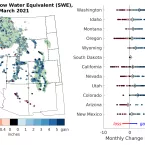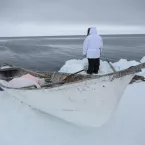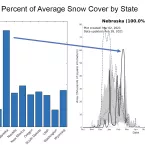Arctic sea ice appears to have reached its maximum extent on March 21, 2021, tying for seventh lowest in the 43-year satellite record.
Our Research
As climate changes, how do Earth's frozen areas affect our planet and impact society?
In this section
Related News & Stories
Filter by:

Analysis - Snow Today
For snow water equivalent (SWE), the prevailing La Niña pattern persisted through March, with above average SWE in the north and below average SWE in the south. A blizzard in mid-March brought widespread and deep snow...

News Release
Arctic sea ice has likely reached its maximum extent for the year, at 14.77 million square kilometers (5.70 million square miles) on March 21, 2021, according to scientists at the National Snow and Ice Data Center (NSIDC) at the Universi

ELOKA Update
Since 2006, the Exchange for Local Observations and Knowledge of the Arctic (ELOKA) program at the National Snow and Ice Data Center (NSIDC) has worked with Indigenous organizations, community partners and researchers across the Arc
Analysis - Sea Ice Today
Sea ice extent for February 2021 tracked well below average, but at month’s end was still higher than levels recorded in several recent years. Extent grew at an average pace.

Analysis - Snow Today
Snow-covered area in the western United States increased from 54 percent of average in January to 77 percent in February, and likely reached maximum coverage on February 17, two weeks later than average. Snow cover days increased significantly...